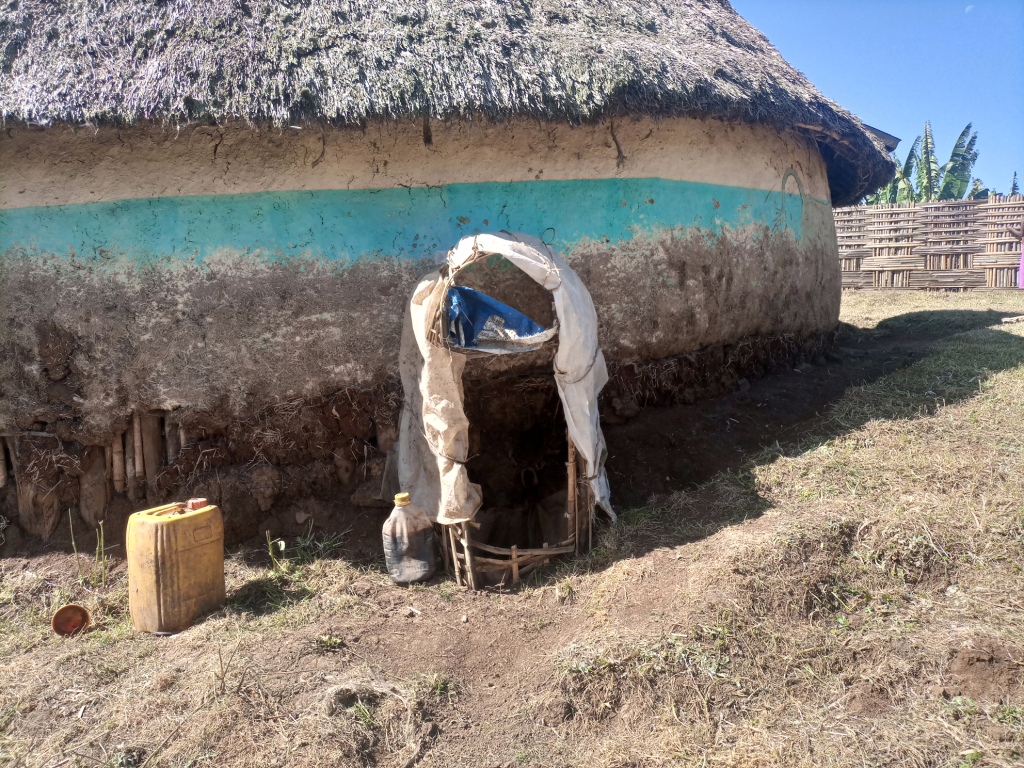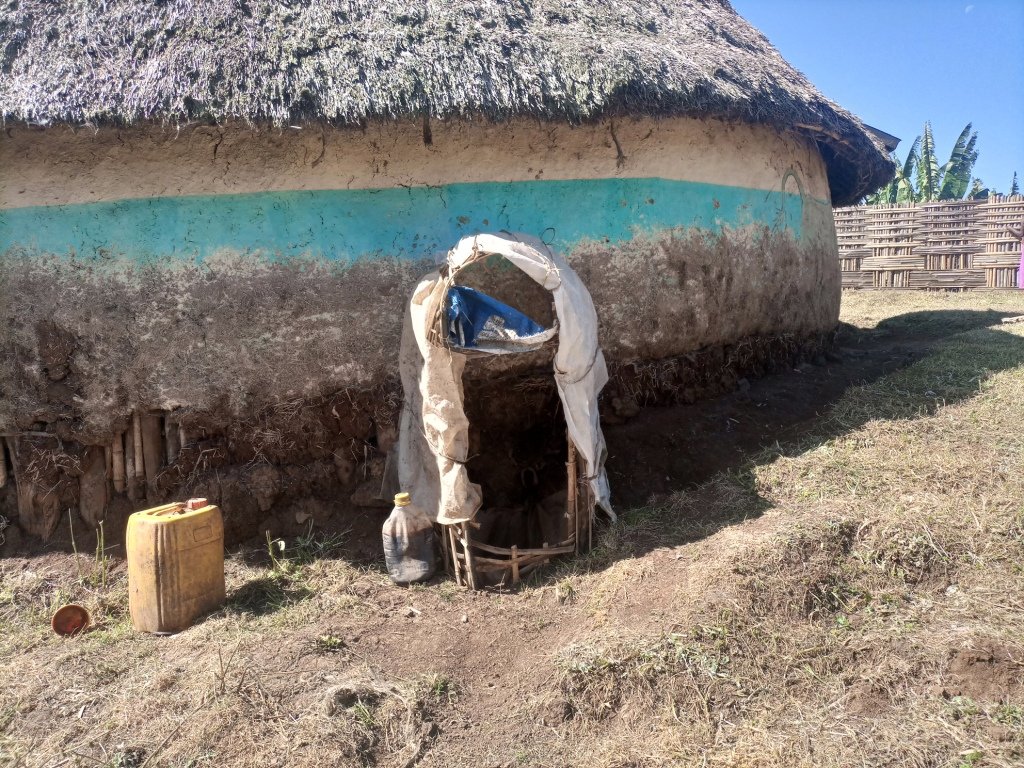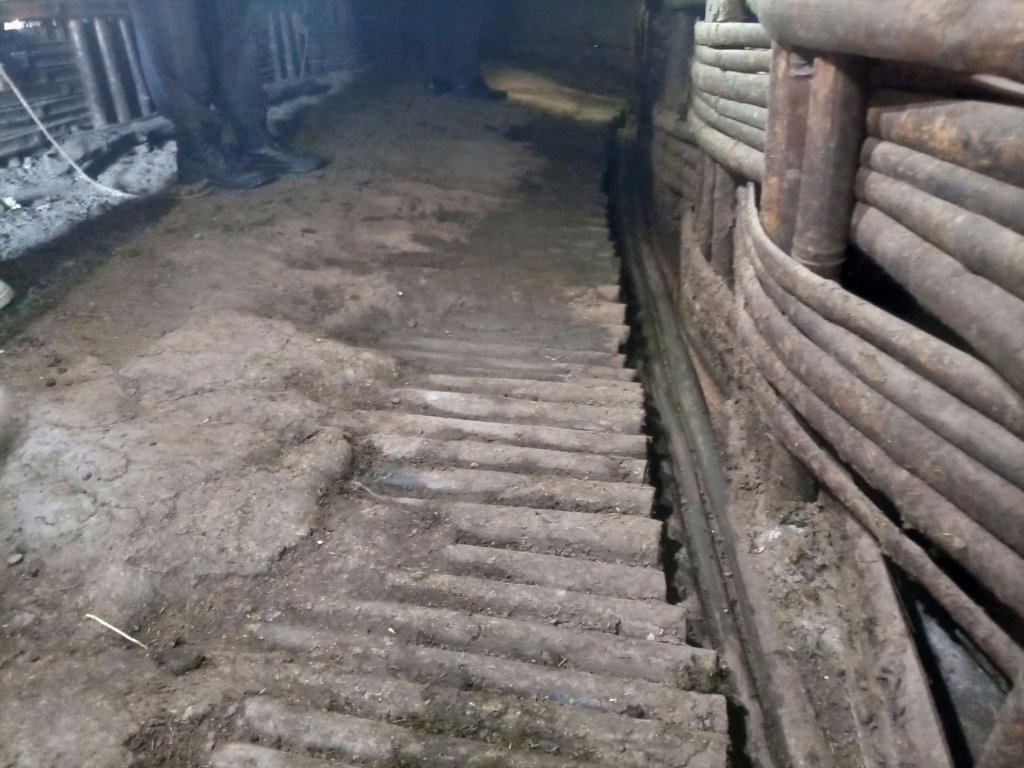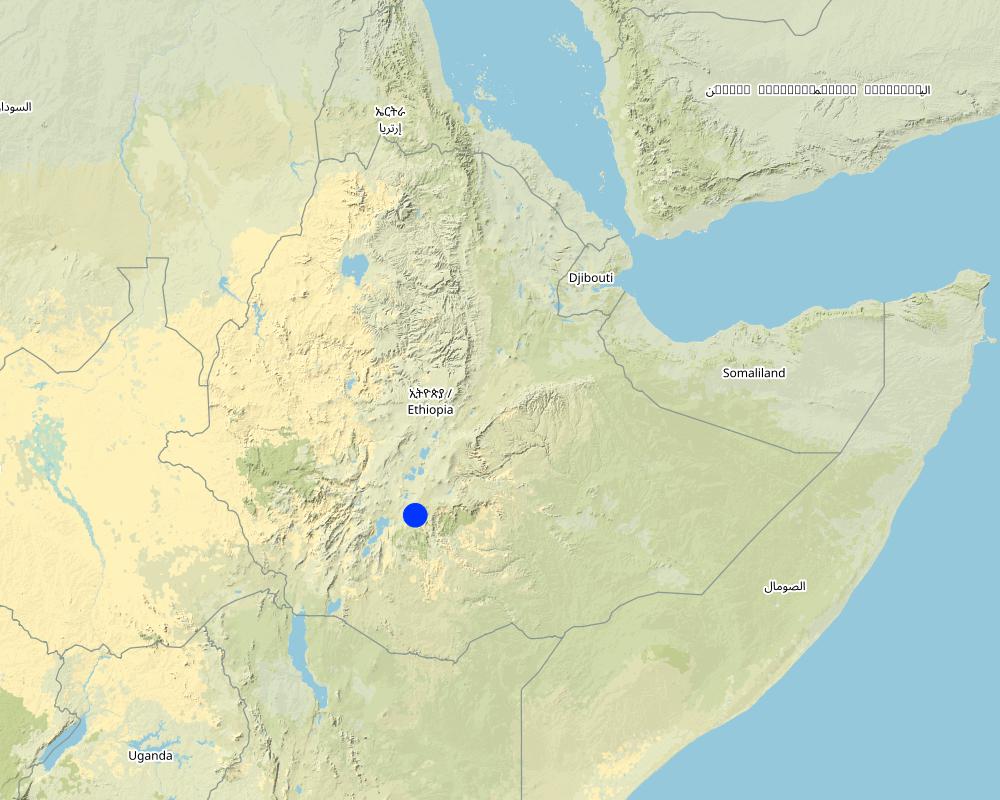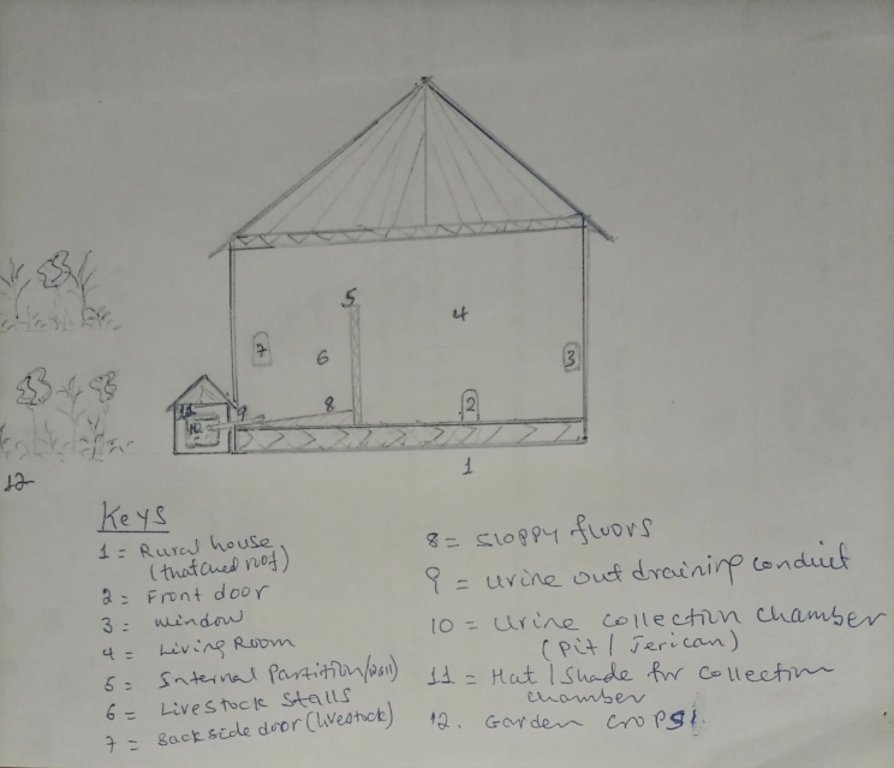Livestock Urine Collection and Use [Ethiopie]
- Création :
- Mise à jour :
- Compilateur : GERBA LETA
- Rédacteurs : Kidist Yilma, Julia Doldt, Noel Templer
- Examinateurs : William Critchley, Rima Mekdaschi Studer
Yeshint Madaberya
technologies_6623 - Ethiopie
Voir les sections
Développer tout Réduire tout1. Informations générales
1.2 Coordonnées des personnes-ressources et des institutions impliquées dans l'évaluation et la documentation de la Technologie
Personne(s)-ressource(s) clé(s)
exploitant des terres:
Shone Wachara
Farmer
Ethiopie
Nom du projet qui a facilité la documentation/ l'évaluation de la Technologie (si pertinent)
Soil protection and rehabilitation for food security (ProSo(i)l)Nom du ou des institutions qui ont facilité la documentation/ l'évaluation de la Technologie (si pertinent)
Alliance Bioversity and International Center for Tropical Agriculture (Alliance Bioversity-CIAT) - Kenya1.3 Conditions relatives à l'utilisation par WOCAT des données documentées
Le compilateur et la(les) personne(s) ressource(s) acceptent les conditions relatives à l'utilisation par WOCAT des données documentées:
Oui
1.4 Déclaration sur la durabilité de la Technologie décrite
Est-ce que la Technologie décrite ici pose problème par rapport à la dégradation des terres, de telle sorte qu'elle ne peut pas être déclarée comme étant une technologie de gestion durable des terres?
Non
Commentaires:
The technology replaces the chemical fertilizer, urea, to restore soil fertility and improve vegetative growth and crop production. Also, it serves as a pesticide to manage insect pests.
1.5 Référence au(x) Questionnaires sur les Approches de GDT (documentées au moyen de WOCAT)
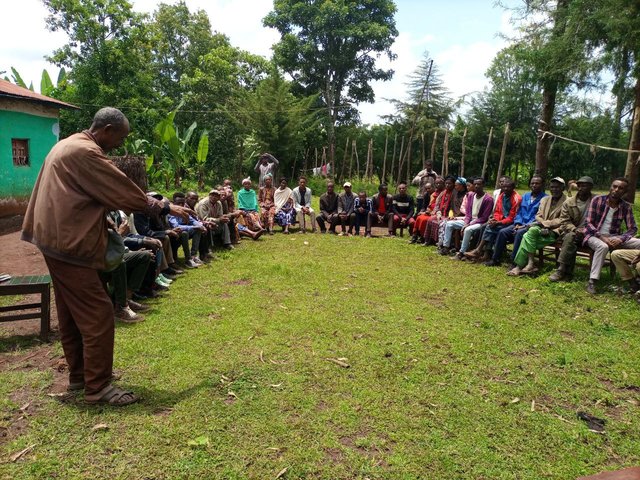
Groupe de Recherche et de Vulgarisation Agricole (FREG) [Ethiopie]
Un Groupe de Recherche et de Vulgarisation Agricole Paysan (GRVAP - ou FREG en anglais) regroupe environ 50 agriculteurs ou plus dans un kébélé (unité administrative inférieure), avec trois sous-groupes de 17 à 20 personnes chacun vivant dans un paysage homogène. Il s'agit d'une institution locale établie pour favoriser l'apprentissage …
- Compilateur : GERBA LETA
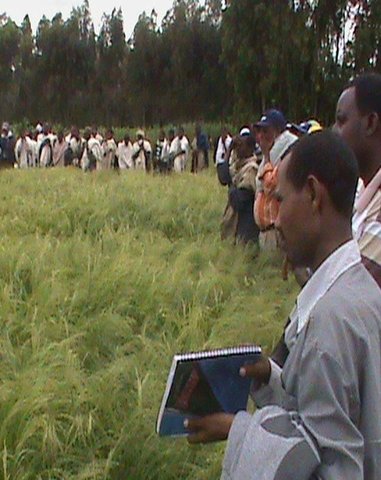
Farmer-Research-Extension Group (FREG) [Ethiopie]
Farmer-Research-Extension Group (FREG) is a grass root level platform aims to bridge gaps on agricultural technology transfer between research and extension linkage and provide a platform of 20-30 members from research, extension and farmer for their joint learning and active participatory role in agricultural technology evaluation and dessimination.
- Compilateur : Gizaw Desta Gessesse
2. Description de la Technologie de GDT
2.1 Courte description de la Technologie
Définition de la Technologie:
Collection of livestock urine allows resource-poor farmers to capture nutrient-rich livestock waste and use it to substitute urea fertilizer. It is a liquid organic product that restores soil fertility and pest management.
2.2 Description détaillée de la Technologie
Description:
Enset, the “false banana”, is a perennial that grows well under the supply of organic fertilizers (farmyard manure, urine, compost and other household refuse). In the enset farming system, farmers traditionally shelter their livestock behind a partition within the main house. They construct a sloping floor in the livestock stall to allow the urine to drain into a narrow channel that leads to nearby enset and vegetable plots. However, construction of a collection chamber on the outlet side is an innovative approach which allows for better use of the urine. The collected urine fertilizes annual crops such as barley, maize, and vegetables - notably kale, carrots, and onions, via foliar and basal applications. Land users collect and preserve the urine for about 15 days before applying it to the target crops for the intended purposes. The urine is also used for pest management such as aphids and cutworms. According to the land user interviewed about 20 litres a day can be collected from six cattle. This implies the potential to collect about 7 cubic metres a year by a farmer: a considerable resource that should not be lost when there is an urgent need to restore soil fertility given ongoing and severe problems with land degradation. Therefore, urine collection and storage can be a way of reducing substantial investment in chemical fertilizers. To learn and showcase the benefits of urine as a replacement for urea fertilizer, a farmer sprayed 80 litres of urine twice onto 600 m2 of a ISFM+ barley demonstration plot. The sprayed amount replaced the equivalent of 6 kg urea that currently costs about 300 ETB.
Housing animals enables the collection of a reasonable quantity of urine to restore the soil fertility at the homestead and on the farm. Locally available bamboo helps to construct partitions and stall floors for the livestock as well as serving as a pipeline to drain the urine into a collection chamber. The benefits of applying urine goes beyond simply urea replacement, and its potential is merely limited by land users knowledge, skills, and motivation. These can be acquired via training, demonstration, exchange visit, and social learning. Land users like the role of urine in restoring soil fertility and boosting production. Furthermore, urine serves as integrated pest management via targeted application, deterring insects. However, the smell of the urine is unpleasant and may deter farmers from its use as they do not have safety clothes or masks to use when spraying the crop.
2.3 Photos de la Technologie
Remarques générales concernant les photos:
The photo portrays the floor orientation and the livestock partition/ stall drainage canal that leads urine to the collection chamber outside the house.
2.4 Vidéos de la Technologie
Commentaire, brève description:
Video for this technology was not captured.
2.5 Pays/ région/ lieux où la Technologie a été appliquée et qui sont couverts par cette évaluation
Pays:
Ethiopie
Région/ Etat/ Province:
Sidama
Autres spécifications du lieu:
Tuticha Kebele 01
Spécifiez la diffusion de la Technologie:
- appliquée en des points spécifiques ou concentrée sur une petite surface
Est-ce que les sites dans lesquels la Technologie est appliquée sont situés dans des zones protégées en permanence?
Non
Map
×2.6 Date de mise en œuvre de la Technologie
Indiquez l'année de mise en œuvre:
2022
2.7 Introduction de la Technologie
Spécifiez comment la Technologie a été introduite: :
- grâce à l'innovation d'exploitants des terres
- dans le cadre d'un système traditionnel (> 50 ans)
- par le biais de projets/ d'interventions extérieures
Commentaires (type de projet, etc.) :
Purely collecting and using urine for target application to the crop as a replacement for urea fertilizer was introduced by ISFM+ of the GIZ. However, land users used to drain slurry of manure and urine from livestock stall to the nearby enset farm. Land users forge spraying vessels and collection pits lined with plastic materials and temporary shade to urine collection points.
3. Classification de la Technologie de GDT
3.1 Principal(aux) objectif(s) de la Technologie
- améliorer la production
- réduire, prévenir, restaurer les terres dégradées
- préserver l'écosystème
- conserver/ améliorer la biodiversité
- créer un impact économique positif
3.2 Type(s) actuel(s) d'utilisation des terres, là où la Technologie est appliquée
Les divers types d'utilisation des terres au sein du même unité de terrain: :
Non

Terres cultivées
- Cultures annuelles
- Cultures pérennes (non ligneuses)
Cultures annuelles - Précisez les cultures:
- céréales - orge
- cultures fourragères - graminées
- légumineuses et légumes secs - pois
- plantes à racines et à tubercules - pommes de terre
- légumes - légumes à feuilles (laitues, choux, épinards, autres)
- False banana (enset)
Nombre de période de croissance par an: :
- 2
Précisez:
Belg (short rain) and Meher (long rain).
Est-ce que les cultures intercalaires sont pratiquées?
Non
Est-ce que la rotation des cultures est appliquée?
Oui
Si oui, veuillez préciser:
Cereals, like barley, rotate with legumes (such as field peas or faba beans).
3.3 Est-ce que l’utilisation des terres a changé en raison de la mise en œuvre de la Technologie ?
Est-ce que l’utilisation des terres a changé en raison de la mise en œuvre de la Technologie ?
- Non (Passez à la question 3.4)
3.4 Approvisionnement en eau
Approvisionnement en eau des terres sur lesquelles est appliquée la Technologie:
- pluvial
Commentaires:
Bimodal rainfall is received twice yearly (short rain Mid-February to Mid-April, and prolonged rain from June to September).
3.5 Groupe de GDT auquel appartient la Technologie
- gestion intégrée cultures-élevage
- gestion intégrée de la fertilité des sols
- lutte intégrée contre les ravageurs et les maladies (incluant l'agriculture biologique)
3.6 Mesures de GDT constituant la Technologie

pratiques agronomiques
- A2: Matière organique/ fertilité du sol

modes de gestion
- M7: Autres
Commentaires:
Crop protection: it plays the role of Integrated Pest Management (IPM).
3.7 Principaux types de dégradation des terres traités par la Technologie

dégradation chimique des sols
- Cn: baisse de la fertilité des sols et réduction du niveau de matière organique (non causée par l’érosion)

dégradation biologique
- Bq: baisse de la quantité/ biomasse
- Bp: augmentation des insectes nuisibles (ravageurs)/ maladies, baisse des prédateurs
3.8 Prévention, réduction de la dégradation ou réhabilitation des terres dégradées
Spécifiez l'objectif de la Technologie au regard de la dégradation des terres:
- réduire la dégradation des terres
- restaurer/ réhabiliter des terres sévèrement dégradées
Commentaires:
The nitrogen in urine stimulates the growth of various crops and non-crop wild species and restores degraded and potentially degradable lands.
4. Spécifications techniques, activités, intrants et coûts de mise en œuvre
4.1 Dessin technique de la Technologie
Spécifications techniques (associées au dessin technique):
The urine collection chamber is set up adjacent to the rural house on the side of livestock stalls. It receives urine that drains out of the sloping floor intentionally constructed using stone or bamboo to drain the liquid wastes through conduit directly to the collection chambers. A ditch that is placed adjacent to the outlet also takes the slurry to the nearby farm/garden. The dimension of the collection chamber and the types of materials used to establish the technology varies depending on resource availability or the number of livestock held by the land user. Other materials such as concrete pits or pits lined by google membranes can be used. Furthermore, jerrican or clay pots are the other alternative tools to collect urine. The different local materials replace the use of expensive materials. Small protective caps over the chamber is recommendable to protect the collected urine from rain and the heat of the sun that triggers the volatilization loss of urea. It is also possible to note additional information from the associated keys to describe the sketch.
Auteur:
Gerba Leta
Date:
30/03/2023
4.2 Informations générales sur le calcul des intrants et des coûts
Spécifiez la manière dont les coûts et les intrants ont été calculés:
- par entité de la Technologie
autre/ monnaie nationale (précisez):
ETB
Indiquez le taux de change des USD en devise locale, le cas échéant (p.ex. 1 USD = 79.9 réal brésilien): 1 USD = :
53,6283
Indiquez le coût salarial moyen de la main d'œuvre par jour:
500
4.3 Activités de mise en place/ d'établissement
| Activité | Calendrier des activités (saisonnier) | |
|---|---|---|
| 1. | Construct collection chamber | Dry season |
| 2. | Construct hats or covering lid for the chamber/collection pit | Dry season |
| 3. | Lining drainage line heading to the pit with concrete | Dry season |
| 4. | Storage vessels/barrel | Anytime |
| 5. | Supplying safety clothes (wear, boots, gloves and mask) | In advance |
Commentaires:
Urine collection chambers, lids or roofs, storage vessels, safety wears, and spraying tools are essential for collecting, storing, and further treating urine before use.
4.4 Coûts et intrants nécessaires à la mise en place
| Spécifiez les intrants | Unité | Quantité | Coûts par unité | Coût total par intrant | % des coût supporté par les exploitants des terres | |
|---|---|---|---|---|---|---|
| Main d'œuvre | Casual labor | no. | 4,0 | 250,0 | 1000,0 | 100,0 |
| Main d'œuvre | Carpentering | no. | 1,0 | 1000,0 | 1000,0 | 50,0 |
| Equipements | Safety wears (shirt & trousers, gloves, mask, boots) | Lump sum | 1,0 | 3000,0 | 3000,0 | |
| Equipements | Watering cane | no. | 1,0 | 1000,0 | 1000,0 | |
| Engrais et biocides | Effective Micro Organism | Litre | 2,0 | 100,0 | 200,0 | 50,0 |
| Matériaux de construction | Cement | kg | 100,0 | 20,0 | 2000,0 | 50,0 |
| Matériaux de construction | Stone | m3 | 1,0 | 2000,0 | 2000,0 | 100,0 |
| Matériaux de construction | Corrugated iron | pcs | 2,0 | 1000,0 | 2000,0 | 50,0 |
| Matériaux de construction | Posts and nails | Lump sum | 1,0 | 1000,0 | 1000,0 | 50,0 |
| Coût total de mise en place de la Technologie | 13200,0 | |||||
| Coût total de mise en place de la Technologie en dollars américains (USD) | 246,14 | |||||
Si le coût n'est pas pris en charge à 100% par l'exploitant des terres, indiquez qui a financé le coût restant:
ISFM+ of the GIZ
Commentaires:
For the model farmer who pilots livestock urine collection for soil amendment and management of pests, supporting the construction of a standard collection chamber and supplying associated kits helps to train and facilitate scaling of the technology in the best way. Effective Microorganisms (EMO) is an input being tested to investigate whether it has the property of changing the stink of the urine collected for storage and use on the farm.
4.5 Activités d'entretien/ récurrentes
| Activité | Calendrier/ fréquence | |
|---|---|---|
| 1. | Effective Microorganisms | Throughout collection and application |
Commentaires:
The use of EMO to change the bad smell of urine, particularly during storage and application needs to be further investigated to prove and use it to reduce the abhorred side of collecting and applying urine for soil amendment and pest management.
4.6 Coûts et intrants nécessaires aux activités d'entretien/ récurrentes (par an)
| Spécifiez les intrants | Unité | Quantité | Coûts par unité | Coût total par intrant | % des coût supporté par les exploitants des terres | |
|---|---|---|---|---|---|---|
| Main d'œuvre | EMO | Litre | 6,0 | 100,0 | 600,0 | 100,0 |
| Main d'œuvre | Family labor | no. | 52,0 | 100,0 | 5200,0 | 100,0 |
| Coût total d'entretien de la Technologie | 5800,0 | |||||
| Coût total d'entretien de la Technologie en dollars américains (USD) | 108,15 | |||||
Si le coût n'est pas pris en charge à 100% par l'exploitant des terres, indiquez qui a financé le coût restant:
NA
Commentaires:
With the assumption that the land user can collect, treat and use about 140 liters of urine per week for different crops, family labor can be used at a lower rate as it is not a full-day operation. Despite our estimation, material and labour costs change in Ethiopia persistently because of market instability and economic crisis that is not uncommon since the outbreak of COVID-19 in 2020.
4.7 Facteurs les plus importants affectant les coûts
Décrivez les facteurs les plus importants affectant les coûts :
Economic crisis, spiking inflation, and overall labour and material market cost instability.
5. Environnement naturel et humain
5.1 Climat
Précipitations annuelles
- < 250 mm
- 251-500 mm
- 501-750 mm
- 751-1000 mm
- 1001-1500 mm
- 1501-2000 mm
- 2001-3000 mm
- 3001-4000 mm
- > 4000 mm
Spécifications/ commentaires sur les précipitations:
Receive bimodal rainfall with a summer maximum.
Zone agro-climatique
- subhumide
The rainfall distribution is nearly consistent. The temperature is cold typical of highland weather conditions.
5.2 Topographie
Pentes moyennes:
- plat (0-2 %)
- faible (3-5%)
- modéré (6-10%)
- onduleux (11-15%)
- vallonné (16-30%)
- raide (31-60%)
- très raide (>60%)
Reliefs:
- plateaux/ plaines
- crêtes
- flancs/ pentes de montagne
- flancs/ pentes de colline
- piémonts/ glacis (bas de pente)
- fonds de vallée/bas-fonds
Zones altitudinales:
- 0-100 m
- 101-500 m
- 501-1000 m
- 1001-1500 m
- 1501-2000 m
- 2001-2500 m
- 2501-3000 m
- 3001-4000 m
- > 4000 m
Indiquez si la Technologie est spécifiquement appliquée dans des:
- non pertinent
Commentaires et précisions supplémentaires sur la topographie:
The topography is unremitting ups and downs.
5.3 Sols
Profondeur moyenne du sol:
- très superficiel (0-20 cm)
- superficiel (21-50 cm)
- modérément profond (51-80 cm)
- profond (81-120 cm)
- très profond (>120 cm)
Texture du sol (de la couche arable):
- moyen (limoneux)
Texture du sol (> 20 cm sous la surface):
- moyen (limoneux)
Matière organique de la couche arable:
- moyen (1-3%)
Si disponible, joignez une description complète du sol ou précisez les informations disponibles, par ex., type de sol, pH/ acidité du sol, capacité d'échange cationique, azote, salinité, etc.
Not available
5.4 Disponibilité et qualité de l'eau
Profondeur estimée de l’eau dans le sol:
5-50 m
Disponibilité de l’eau de surface:
moyenne
Qualité de l’eau (non traitée):
eau potable
La qualité de l'eau fait référence à:
à la fois les eaux souterraines et de surface
La salinité de l'eau est-elle un problème? :
Non
La zone est-elle inondée?
Non
Commentaires et précisions supplémentaires sur la qualité et la quantité d'eau:
Surface and groundwater quality in the highland areas of Sidama region was not suggested as an issue. Rather, surface water can be polluted by soil erosion before the crops cover the ground.
5.5 Biodiversité
Diversité des espèces:
- moyenne
Diversité des habitats:
- faible
Commentaires et précisions supplémentaires sur la biodiversité:
The technology is piloted around the homestead. Agriculture is highly intensified in the area. Hence, only plantation forest or peripheral plants such as Eucalyptus species are the common tree species. This signals medium to lower species diversity that similarly applicable to habitat diversity.
5.6 Caractéristiques des exploitants des terres appliquant la Technologie
Sédentaire ou nomade:
- Sédentaire
Orientation du système de production:
- exploitation mixte (de subsistance/ commerciale)
Niveau relatif de richesse:
- moyen
Individus ou groupes:
- individu/ ménage
Niveau de mécanisation:
- travail manuel
Genre:
- hommes
Age des exploitants des terres:
- personnes d'âge moyen
Indiquez toute autre caractéristique pertinente des exploitants des terres:
The land user doesn't have off-farm income. He generates his livelihood from 2 hectares of land and a few livestock.
5.7 Superficie moyenne des terres utilisées par les exploitants des terres appliquant la Technologie
- < 0,5 ha
- 0,5-1 ha
- 1-2 ha
- 2-5 ha
- 5-15 ha
- 15-50 ha
- 50-100 ha
- 100-500 ha
- 500-1 000 ha
- 1 000-10 000 ha
- > 10 000 ha
Cette superficie est-elle considérée comme de petite, moyenne ou grande dimension (en se référant au contexte local)?
- petite dimension
Commentaires:
Farming is operationalized by hoes (hand-dug) to grow cereal crops. Otherwise, enset culture demands hand digging.
5.8 Propriété foncière, droits d’utilisation des terres et de l'eau
Propriété foncière:
- état
- individu, avec titre de propriété
Droits d’utilisation des terres:
- individuel
Droits d’utilisation de l’eau:
- accès libre (non organisé)
Est-ce que les droits d'utilisation des terres sont fondés sur un système juridique traditionnel?
Oui
Précisez:
The land was inherited from the family line. However, the adopted national constitution declared land belongs to the state and the users. Thus, usufructs issued by the government to the land user.
Commentaires:
In Ethiopia, the 1995 constitution declared the land as state property but the farmer has usufructs right. As a result, the certificate was issued except in the pastoralist areas of the country. Of course, most people inherited specific plots of land from their lineage, though there was frequent land redistribution during the Derg and early years of the EPRDF regime.
5.9 Accès aux services et aux infrastructures
santé:
- pauvre
- modéré
- bonne
éducation:
- pauvre
- modéré
- bonne
assistance technique:
- pauvre
- modéré
- bonne
emploi (par ex. hors exploitation):
- pauvre
- modéré
- bonne
marchés:
- pauvre
- modéré
- bonne
énergie:
- pauvre
- modéré
- bonne
routes et transports:
- pauvre
- modéré
- bonne
eau potable et assainissement:
- pauvre
- modéré
- bonne
services financiers:
- pauvre
- modéré
- bonne
Commentaires:
Although they mentioned the quality of both ground and surface water is good in the preceding section, the level of sanitation is not significant as the resident use water from the springs for drink and other household activities.
6. Impacts et conclusions
6.1 Impacts sur site que la Technologie a montrés
Impacts socio-économiques
Production
production agricole
Quantité avant la GDT:
70 kg from 0.12 hectare of land.
Quantité après la GDT:
400 kg from the same land.
Commentaires/ spécifiez:
With the application of ISFM+ approach and urine as a replacement for Urea, a substantial yield increment was achieved.
qualité des cultures
Commentaires/ spécifiez:
As the technology is at its early stage of implementation where documentation is not well organized, it was impossible to quantify the harvest and quality of the crop.
gestion des terres
Revenus et coûts
dépenses pour les intrants agricoles
Commentaires/ spécifiez:
As urine complement urea fertilizer, other nutrients from Sulfur, Phosphorus and other micro nutrients remain important.
revenus agricoles
Impacts socioculturels
sécurité alimentaire/ autosuffisance
situation sanitaire
opportunités culturelles
connaissances sur la GDT/ dégradation des terres
Commentaires/ spécifiez:
Crop response to urine application is an evidence based for adoption of the SLM technology.
Impacts écologiques
Sols
humidité du sol
couverture du sol
perte en sol
accumulation de sol
matière organique du sol/ au dessous du sol C
Commentaires/ spécifiez:
Not practically measured and documented. Besides, the technology is at earlier phase to judge the real impacts.
acidité
Biodiversité: végétale, animale
Couverture végétale
biomasse/ au dessus du sol C
diversité des habitats
contrôle des animaux nuisibles/ maladies
Commentaires/ spécifiez:
It has tangible impacts on managing pests.
Réduction des risques de catastrophe et des risques climatiques
émissions de carbone et de gaz à effet de serre
Commentaires/ spécifiez:
As a foliar application of urine to the target crops might be subjected to evaporation, if not good hours of the day are not identified, there is a likelihood of emission. However, its amount is very insignificant as the little amount used for foliar feeding.
Précisez l'évaluation des impacts sur site (sous forme de mesures):
The on-site assessment is made based on conceptual knowledge of the beneficial effects of collecting and applying livestock urine as a replacement to urea fertilizer and the farmer and experts' knowledge on the fertilizer and pesticidal effects of liquid urine. Otherwise, careful documentation of various types of data is commendable to quantify and properly address such comprehensive questions included in the questionnaire.
6.2 Impacts hors site que la Technologie a montrés
inondations en aval
envasement en aval
pollution des rivières/ nappes phréatiques
Commentaires/ spécifiez:
The impact has not yet measured.
impact des gaz à effet de serre
Précisez l'évaluation des impacts extérieurs (sous forme de mesures):
As an optimum application of urine substitute urea fertilizer, it favors the growth of diverse plant species, positively contributing to the overall ecosystem services and reducing degradations. However, it has not been empirically measured.
6.3 Exposition et sensibilité de la Technologie aux changements progressifs et aux évènements extrêmes/catastrophes liés au climat (telles que perçues par les exploitants des terres)
Changements climatiques progressifs
Changements climatiques progressifs
| Saison | Augmentation ou diminution | Comment la Technologie fait-elle face à cela? | |
|---|---|---|---|
| précipitations saisonnières | saison des pluies/ humide | décroît | modérément |
Extrêmes climatiques (catastrophes)
Catastrophes climatiques
| Comment la Technologie fait-elle face à cela? | |
|---|---|
| sécheresse | pas connu |
Autres conséquences liées au climat
Autres conséquences liées au climat
| Comment la Technologie fait-elle face à cela? | |
|---|---|
| prolongement de la période de croissance | bien |
| réduction de la période de croissance | modérément |
Commentaires:
The technology has no direct influence on climate change/climate variability in the short term.
6.4 Analyse coûts-bénéfices
Quels sont les bénéfices comparativement aux coûts de mise en place (du point de vue des exploitants des terres)?
Rentabilité à court terme:
positive
Rentabilité à long terme:
très positive
Quels sont les bénéfices comparativement aux coûts d'entretien récurrents (du point de vue des exploitants des terres)?
Rentabilité à court terme:
positive
Rentabilité à long terme:
très positive
Commentaires:
Post-establishment, the maintenance costs are believed to be very low. This shows the technology is cost-effective to resource-poor farmers.
6.5 Adoption de la Technologie
- 1-10%
Si disponible, quantifiez (nombre de ménages et/ou superficie couverte):
Forty-four (44) farmers are currently piloting this technology. Of these, 30 farmers are innovative and adopted the technology on their own using locally available materials to collect and spray urine as a complement to urea fertilizer to the target crops.
De tous ceux qui ont adopté la Technologie, combien d'entre eux l'ont fait spontanément, à savoir sans recevoir aucune incitation matérielle, ou aucune rémunération? :
- 51-90%
Commentaires:
Thirty farmers represent the most significant portion who spontaneously took up the technology.
6.6 Adaptation
La Technologie a-t-elle été récemment modifiée pour s'adapter à l'évolution des conditions?
Oui
autre (précisez):
Unavailability of the right kits/materials
Spécifiez l'adaptation de la Technologie (conception, matériaux/ espèces, etc.):
Land users use locally available materials to collect, store and spray the urine on the target crops. Meaning the concept is introduced in a way it matches or complements conventional uses of livestock wastes to improve the fertility of soil on which Enset, a perennial crop is growing. Otherwise, standard designs or types of materials and safety precautions kits have not been associated with the technology. Despite the unavailability of the necessary kits for the establishment of the technology, farmers forge their mechanisms to collect and use urine. This indicates the innovativeness of the land/technology users.
6.7 Points forts/ avantages/ possibilités de la Technologie
| Points forts/ avantages/ possibilités du point de vue de l'exploitant des terres |
|---|
| Reduce costs spent on chemical fertilizer. |
| Increase yield per unit of land and land users' income in general. Furthermore, it increases the number of tillers per plant and overall biomass yield. |
| Manage insect pests such as cutworms and aphids. |
| Points forts/ avantages/ possibilités du point de vue du compilateur ou d'une autre personne ressource clé |
|---|
| It seems a good substitute for chemical fertilizer, urea. It improves farmers' access to wasted resources without being used. |
| It restores the fertility of the soil and improves production and productivity, and species diversity which improves ecological benefits on top of the high return from the most minor investment in fertilizer. |
6.8 Faiblesses/ inconvénients/ risques de la Technologie et moyens de les surmonter
| Faiblesses/ inconvénients/ risques du point de vue de l’exploitant des terres | Comment peuvent-ils être surmontés? |
|---|---|
| Bad smell of the urine when sprayed on the target crops. | By ensuring access to necessary tools. Otherwise, they will not give up on using it since the benefit outweighs the loss. |
| Lack of spraying materials. | If not accessed spraying tools, the farmer committed to using locally forged ones. |
| Faiblesses/ inconvénients/ risques du point de vue du compilateur ou d'une autre personne ressource clé | Comment peuvent-ils être surmontés? |
|---|---|
| Stinking of the urine while applying to the crop. | Try to test whether using Effective Micro Organism (EMO) can improve urine smell before using it in the field. |
| Lack of safety wear and associated necessary kits. | Improving access to the necessary materials, knowledge, and skills to use the available resources or materials effectively. |
7. Références et liens
7.1 Méthodes/ sources d'information
- visites de terrain, enquêtes sur le terrain
Four (4) persons, including a land user.
- interviews/entretiens avec les exploitants des terres
A farmer
- interviews/ entretiens avec les spécialistes/ experts de GDT
Three (3) persons (district expert, regional SLM specialist, and ISFM+ regional advisor).
Quand les données ont-elles été compilées (sur le terrain)?
14/01/2023
7.2 Références des publications disponibles
Titre, auteur, année, ISBN:
Use of Cow Urine in the Field of Agriculture. Singh, R. 2022
Disponible à partir d'où? Coût?
http://www.pashudhanpraharee.com/use-of-cow-urine-in-the-field-of-agriculture/
Titre, auteur, année, ISBN:
Utilization of urine waste to produce quality cauliflower. Khanal, A., Shakya , S. M., Shah, S. C., Sharma, M. D. 2011.
Disponible à partir d'où? Coût?
https://www.nepjol.info (Free access)
7.3 Liens vers les informations pertinentes en ligne
Titre/ description:
Nitrogen concentration in the urine of cattle, sheep and deer grazing a common ryegrass/cocksfoot/white clover pasture. Doi.org/10.1080/00288233.2010.499899
URL:
https://www.tandfonline.com
7.4 Observations d'ordre général
Not every question in the questionnaire is relevant to the Livestock urine collection for soil amendment and integrated pest management practices. Urine collection and use does not address every kind of land degradation stated in the questionnaire. However, it directly or indirectly addresses some of the SLM-related issues.
Liens et modules
Développer tout Réduire toutLiens

Groupe de Recherche et de Vulgarisation Agricole (FREG) [Ethiopie]
Un Groupe de Recherche et de Vulgarisation Agricole Paysan (GRVAP - ou FREG en anglais) regroupe environ 50 agriculteurs ou plus dans un kébélé (unité administrative inférieure), avec trois sous-groupes de 17 à 20 personnes chacun vivant dans un paysage homogène. Il s'agit d'une institution locale établie pour favoriser l'apprentissage …
- Compilateur : GERBA LETA

Farmer-Research-Extension Group (FREG) [Ethiopie]
Farmer-Research-Extension Group (FREG) is a grass root level platform aims to bridge gaps on agricultural technology transfer between research and extension linkage and provide a platform of 20-30 members from research, extension and farmer for their joint learning and active participatory role in agricultural technology evaluation and dessimination.
- Compilateur : Gizaw Desta Gessesse
Modules
Aucun module trouvé


